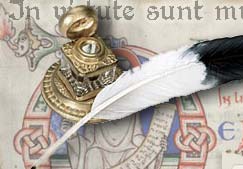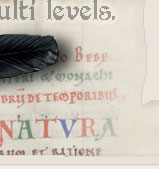Hi,
Although I am really a newbie, I can't resist putting my spoon into this soup. But I also happen to think that the manuscript might actually need a fresh look, because, as dodovan pointed out, scientists from various fields seem to have become stuck with interpreting the text from certain points of view, like it being from the 16th century.
Now, to my observations. Please note that I only became aware of the subject of this particular manuscript yesterday, so kindly just push me gently towards the right direction, if you notice any faulty conclusions. As to my background (I believe it would be beneficial to know the viewpoints of the interpreter when they are looking at something as complex as this), I have studies in computer science, such as data mining, I am interested in the history of science in general, have also received some basic education in cognitive science, and I am an amateur painter.
To me it seems there are four possible main lines of inquiry:
1) It is an encoded manuscript
2) It is a manuscript written in natural language, such as a dialect of Chinese, but without using any phonetic alphabet used to write it in our time
3) It is a script written by a naive writer (child, glossolalia, or any other case where the writer does not know what they are writing)
4) It is a hoax
Then what are, to my eye, the weaknesses of each line of inquiry?
Encoded manuscript theory:
If the VM is indeed encoded, one of the points brought by the inquiries of tonybaloney previously on this forum (prior to Leonardo Theory), is that we do not know the number of marks the encoded piece actually covers: According to my knowledge, it was commonplace for monks copying text in the middle ages to start using shorthands. For example, the contemporary mark "@" presumably started as such a mark, used by monks to shorten scripts. Similar examples can be found in contemporary cyrillic alphabet, as the mark for latin 'l', 'm', and 'i' are all just a different number of "spikes", and if you write all these letters together, it easily seems like a mark resembling a continuous wave. Going in from this direction, I think it would be beneficial to try and analyze the whole volume again, bearing in mind, that the number of different marks highly depends upon whether there are actually "shorthand syllables" within or not. Remember, we may also have some markings for sounds that have since been forgotten entirely.
Also the repetition of certain words seems interesting. It is plausible that they are numbers, in written form. To me these repetitive words also seem in some way to increase the odds that this is indeed encrypted, as it would explain, why there aren't any numbers in the manuscript otherwise at all. (Of course it might just be that the book doesn't have any, as it is more descriptive in nature instead of precise with numbers.)
An other point is, what would have been important enough to be encoded? I think this is a key point, as it may guide the cryptologists towards the right vocabulary. Alchemy has been mentioned often - however would that really have been an issue around the 1300s where the carbon dating puts the book? According to general introductions to the history of science, alchemy was pretty much done by everyone, and being prosecuted over it might not have been as frequent as you would suppose in the middle ages. But in order to ponder the motivations, you should first know where it was written, or preferably by whom. If the pictures are indeed related to the text, which I think we can not even say for sure, some of the astronomy section, with it's circles within circles, look like models of the solar system. And this is interesting: It turns out that the structure of the solar system was indeed a heated debate approximately at that time. It could for example be a way to protect some even older manuscript by some greek philosopher, whose view of the system was against the Church's teachings of the time (But this all starts to sound too much like Umberto Eco

).
Obscure language theory
To me, this is a really interesting one. As dodonovan mentioned, I would really want a pollen sample of the book as well, to know whether to place it in Europe, Asia, or Africa. However, I think it is really important to remember, this might not be the only copy of the work. Indeed, this might be the only surviving copy, but not necessarily the only one. On the other hand, I also suspect that the different parts in the book may just have been bound together even later, as someone noticed these seem to be from the same hand.
If it's an obscure language, I'd like to mention a couple of things: First of all, the writer, who invented this way of writing down another language, might not have been a fluent speaker of the language. They also can have a much different mental image of what language is: For example, as it seems certain letters only turn out in the beginning or in the end of a word, it could be, that these are morpheme suffixes or prefixes of the language, but the writer has come from the Latin family of language and has marked these down with different letters, as they have thought it curious, because they are themselves used to prepositions. I think it would make a lot of sense for a person like that to try to force the foreign language into a format they have previously seen. Also they might not be able to hear tonalities, or certain sounds at all, if their ear is too accustomed to certain noises. This for example happens in young kids when they grow up: When they are little they can learn to speak any language without profound accent, but later that ability disappears. We have to remember that the way to represent language was not yet as sophisticated as what we have. But in this case, I believe, there should be (or has at some point been) a volume describing the way to transcript the other language in these marks, which may have been in Latin.
Also if the manuscript is an attempt to write a foreign language, I believe we should have some mentions of it in other books. Writing about what has already been written was a major tradition of scholars in that time. Scarcely any new science was produces at those times, but most of it was critique to what has already been previously said, by Aristotle, for example.
In this case we also have to wonder, whether the pictures are related to the work or not. I remember reading, that monks used to draw pictures in books, when they made copies, because they were simply bored by the work. This could explain, why we have a lot of naked women in the biology section: If you can't even read what the book says, maybe when you're assigned to copy it, you just doodle something into the pages every once in a while. But if the pictures are related to the text, I also think the women hold some key to the journey of the script: At least the biology section is not likely to be Arabic, as the depiction of humans was already banned in the Islamic tradition.
Why then are the plants clearly chimeric? If the book was written about a journey in china, could it be, that the pictures weren't drawn on location, but perhaps described to a scribe afterwards, and then the scholar copied his field notes under those pictures? There can be so many ways to interpret the pictures... To me the plants look like motives on Iberian buildings from the time of the Ottoman empire. On the other hand, the women then again seem to be all depicted in semi frontal position, and despite their nudity, the headdresses, which seem to be from Europe in the middle ages, might give point to what they are. However they are incredibly poorly painted to be taken as middle age art in the usual sense.
Naive Writer theory
This is in a way very compelling, as the book really seems like the work of a child. However, I think, this is incredibly hard to prove. Also, why would it have been written on vellum? Vellum was very expensive, and therefore the texts should hold some meaning, at least to their writer. In general kids or apprentices weren't let near such expensive materials before they were able to show their skills. They probably practiced by drawing on sand, or something similar. I also remember reading that in monasteries, the copying of books was often done in multiple steps: The harder parts done by someone very skilled, and easier parts, like coloring, by the apprentices. Also the theory that this was only written on older vellum seems implausible: Why is there no clear evidence of writing that does not belong to the book? (Or maybe the pictures were drawn on those parts to hide the inferior quality of re-used material?) To this end, more precise dating of individual pages should be done, and perhaps radiography, if it can be done on vellum, to ensure there are no pre-written texts under the pictures.
Hoax
For the VM to be a hoax is also hard to prove: We are missing a motive, and why would someone have destroyed other volumes, probably very expensive as well, to gain 13th century vellum? Also modern carbon dating was not around when the confirmed history of the manuscript begins, so why bother taking something as old as that, and not just something newer? Also same evidence, as in the previous section should be found in that case. Of course, if can be, that the book was already intended as a prank in the 13th century. There is no way to confirm that, and maybe that is why it seems so intriguing.
So hope some of these ramblings give you new ideas on how to approach the subject. Can't wait to see, what new people find about this!







